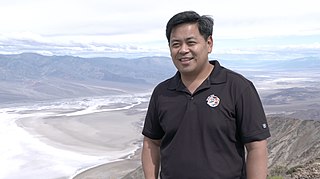
Jet Propulsion Laboratory (JPL) is a federally funded research and development center in La Cañada Flintridge, California, United States. Founded in 1936 by Caltech researchers, the laboratory is now owned and sponsored by the National Aeronautics and Space Administration (NASA) and administered and managed by the California Institute of Technology.

2001 Mars Odyssey is a robotic spacecraft orbiting the planet Mars. The project was developed by NASA, and contracted out to Lockheed Martin, with an expected cost for the entire mission of US$297 million. Its mission is to use spectrometers and a thermal imager to detect evidence of past or present water and ice, as well as study the planet's geology and radiation environment. The data Odyssey obtains is intended to help answer the question of whether life once existed on Mars and create a risk-assessment of the radiation that future astronauts on Mars might experience. It also acts as a relay for communications between the Curiosity rover, and previously the Mars Exploration Rovers and Phoenix lander, to Earth. The mission was named as a tribute to Arthur C. Clarke, evoking the name of his and Stanley Kubrick's 1968 film 2001: A Space Odyssey.

Spacecraft propulsion is any method used to accelerate spacecraft and artificial satellites. In-space propulsion exclusively deals with propulsion systems used in the vacuum of space and should not be confused with space launch or atmospheric entry.

In spacecraft propulsion, a Hall-effect thruster (HET) is a type of ion thruster in which the propellant is accelerated by an electric field. Hall-effect thrusters are sometimes referred to as Hall thrusters or Hall-current thrusters. Hall-effect thrusters use a magnetic field to limit the electrons' axial motion and then use them to ionize propellant, efficiently accelerate the ions to produce thrust, and neutralize the ions in the plume. The Hall-effect thruster is classed as a moderate specific impulse space propulsion technology and has benefited from considerable theoretical and experimental research since the 1960s.

An ion thruster, ion drive, or ion engine is a form of electric propulsion used for spacecraft propulsion. An ion thruster creates a cloud of positive ions from a neutral gas by ionizing it to extract some electrons from its atoms. The ions are then accelerated using electricity to create thrust. Ion thrusters are categorized as either electrostatic or electromagnetic.
A nuclear electric rocket is a type of spacecraft propulsion system where thermal energy from a nuclear reactor is converted to electrical energy, which is used to drive an ion thruster or other electrical spacecraft propulsion technology. The nuclear electric rocket terminology is slightly inconsistent, as technically the "rocket" part of the propulsion system is non-nuclear and could also be driven by solar panels. This is in contrast with a nuclear thermal rocket, which directly uses reactor heat to add energy to a working fluid, which is then expelled out of a rocket nozzle.

A Mars rover is a remote-controlled motor vehicle designed to travel on the surface of Mars. Rovers have several advantages over stationary landers: they examine more territory, they can be directed to interesting features, they can place themselves in sunny positions to weather winter months, and they can advance the knowledge of how to perform very remote robotic vehicle control. They serve a different purpose than orbital spacecraft like Mars Reconnaissance Orbiter. A more recent development is the Mars helicopter.

Mars Science Laboratory (MSL) is a robotic space probe mission to Mars launched by NASA on November 26, 2011, which successfully landed Curiosity, a Mars rover, in Gale Crater on August 6, 2012. The overall objectives include investigating Mars' habitability, studying its climate and geology, and collecting data for a human mission to Mars. The rover carries a variety of scientific instruments designed by an international team.

George David Low was an American aerospace executive and a NASA astronaut. With undergraduate degrees in physics and mechanical engineering and a master's degree in aeronautics and astronautics, he worked in the Jet Propulsion Laboratory (JPL) at the California Institute of Technology in the early 80's, before being picked as an astronaut candidate by NASA in 1984. In addition to holding some technical assignments, he logged more than 700 hours in space, before he left NASA in 1996 to pursue a career in the private sector. He was the son of George M. Low, the manager of the Apollo Spacecraft Program Office, and later, the 14th president of Rensselaer Polytechnic Institute.

Solar electric propulsion (SEP) refers to the combination of solar cells and electric thrusters to propel a spacecraft through outer space. This technology has been exploited in a variety of spacecraft designs by the European Space Agency (ESA), the JAXA, Indian Space Research Organisation (ISRO) and NASA. SEP has a significantly higher specific impulse than chemical rocket propulsion, thus requiring less propellant mass to be launched with a spacecraft. The technology has been evaluated for missions to Mars.

Spacecraft electric propulsion is a type of spacecraft propulsion technique that uses electrostatic or electromagnetic fields to accelerate mass to high speed and thus generating thrust to modify the velocity of a spacecraft in orbit. The propulsion system is controlled by power electronics.

Curiosity is a car-sized Mars rover exploring Gale crater and Mount Sharp on Mars as part of NASA's Mars Science Laboratory (MSL) mission. Curiosity was launched from Cape Canaveral (CCAFS) on November 26, 2011, at 15:02:00 UTC and landed on Aeolis Palus inside Gale crater on Mars on August 6, 2012, 05:17:57 UTC. The Bradbury Landing site was less than 2.4 km (1.5 mi) from the center of the rover's touchdown target after a 560 million km (350 million mi) journey.

Adam Diedrich Steltzner is an American NASA engineer who works for the Jet Propulsion Laboratory (JPL). He worked on several flight projects including Galileo, Cassini, Mars Pathfinder, Mars Exploration Rovers (MER). He was the lead engineer of the Mars Science Laboratory's EDL phase, and helped design, build and test the sky crane landing system.

The Asteroid Redirect Mission (ARM), also known as the Asteroid Retrieval and Utilization (ARU) mission and the Asteroid Initiative, was a space mission proposed by NASA in 2013; the mission was later cancelled. The Asteroid Retrieval Robotic Mission (ARRM) spacecraft would rendezvous with a large near-Earth asteroid and use robotic arms with anchoring grippers to retrieve a 4-meter boulder from the asteroid.

Mars Cube One was a Mars flyby mission launched on 5 May 2018 alongside NASA's InSight Mars lander. It consisted of two nanospacecraft, MarCO-A and MarCO-B, that provided real-time communications to Earth for InSight during its entry, descent, and landing (EDL) on 26 November 2018 - when InSight was out of line of sight from the Earth. Both spacecraft were 6U CubeSats designed to test miniaturized communications and navigation technologies. These were the first CubeSats to operate beyond Earth orbit, and aside from telecommunications they also tested CubeSats' endurance in deep space. On 5 February 2019, NASA reported that both the CubeSats had gone silent by 5 January 2019, and are unlikely to be heard from again. In August 2019, the CubeSats were honored for their role in the successful landing of the InSight lander on Mars.

Psyche is a NASA Discovery Program space mission launched on October 13, 2023 to explore the origin of planetary cores by orbiting and studying the metallic asteroid 16 Psyche beginning in 2029. NASA's Jet Propulsion Laboratory (JPL) manages the project.

David A. Spencer is the Mars Sample Return Campaign Mission Manager at the Jet Propulsion Laboratory. As an aerospace engineer, Spencer designs and operates planetary spacecraft.

NASA's Eyes Visualization is a freely available suite of computer visualization applications created by the Visualization Technology Applications and Development Team at NASA's Jet Propulsion Laboratory (JPL) to render scientifically accurate views of the planets studied by JPL missions and the spacecraft used in that study. The Eyes family of products is available for desktop computers running Windows 7+, and Mac OSX 10.8+. Deep Space Network Now and Experience Curiosity are web-based and available across all platforms. 3D models of spacecraft and other objects are displayed with the option of comparing their size to a human, school bus, or football stadium.

The Power and Propulsion Element (PPE), previously known as the Asteroid Redirect Vehicle propulsion system, is a planned solar electric ion propulsion module being developed by Maxar Technologies for NASA. It is one of the major components of the Lunar Gateway. The PPE will allow access to the entire lunar surface and a wide range of lunar orbits and double as a space tug for visiting craft.

Allen "Al" Chen is an American aerospace engineer. He was the Entry, Descent, and Landing (EDL) Operations Lead on the Mars Science Laboratory mission and the EDL Lead for the Mars 2020 mission.
















